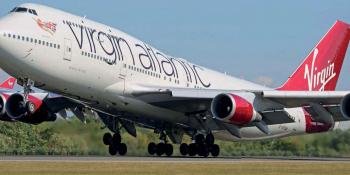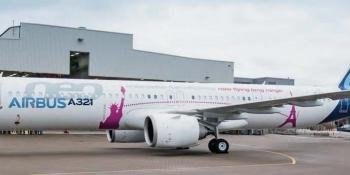
THE ANNOUNCEMENT by Airbus recently that it will end production of its flagship A380 in 2021 was unsurprising.
Sales of the company’s super jumbo have struggled for years. Airbus’ latest orders and deliveries figures, updated in March to account for cancellations, show it sold only sold 290 examples of the A380 after the type’s formal industrial launch back in December 2000, with the last new firm order placed in 2013 by Emirates. The declining backlog forced the manufacturer to scale back production rates in the last few years from the high of 30 aircraft in 2014 down to eight this year.
This didn’t mean axing the aircraft was any less difficult, as Airbus’ outgoing Chief Executive Officer Tom Enders (succeeded in April 2019 by Guillaume Faury) reflected: “It was painful to take the decision after all the effort, money and sweat our employees have poured into that programme, but we have to base our decisions on facts.”
The most important of those facts is that the A380’s quad-jet economics were more expensive than those of the efficient widebody twin-jets such as the Boeing 777 and the A380’s own Airbus stablemate, the A350.
The A380 will of course remain a presence in the skies for years to come; Emirates plans to continue flying the type well into the 2030s and Airbus will continue to support the in-service fleet.
Even so, the axe falling on the A380 as a current-production aircraft marks a line in the sand in the history of commercial air transport. The A380 will probably be the last large passenger airliner with four engines.
As the airline industry commentator John Strickland of JLS Consulting reflected to AIR International: “The capability of aircraft to fly long range on two engines unfortunately means the days of four-engine aircraft are coming to a close in terms of new orders. Twins are the way airlines are going.”
Boeing still offers the 747-8 Intercontinental, the passenger version of the 747-8, but sales of that aircraft have been even weaker than the A380, with just 47 sold since its launch in 2005. Boeing has for years now said the 747-8’s future is tied to air cargo; it has sold 107 examples of the 747-8 Freighter variant so far.
Strickland believes there is logic to the A380 if used to its maximum potential of about 800 seats, which, he said, “would give you a very low cost per seat”. However, no airline has ever used an A380 to that maximum capacity – the nearest is Emirates configuring a subset of its fleet with 615 seats – because, ultimately, there are only so many routes where that amount of capacity is required.
Strickland explained Emirates has been able to operate so many A380s (the carrier had 109 in service as of March 2019, with just 14 more to be delivered before A380 production ends), because, “they’ve built a hub where they’ve got Airbuses connecting Airbuses, 500 seats feeding another 500 seats, which is a logical nature of [passenger] feed”.
For much of the market, however, a platform of the A380’s size is simply too big for the demand on most of their routes and, even if A380-sized seat capacity is required, most operators only need it to a limited extent. It is a telling statistic that most A380 operators only have small fleets of the super jumbo compared to the fleet sizes of their other widebody aircraft, British Airways, for example, operating only 12 A380s compared to 58 777s.
With Emirates so instrumental to the A380’s commercial prospects, it was clear the Gulf carrier would be decisive in the aircraft’s longterm destiny. The airline signed an agreement early in 2018 to buy more examples, but with the airline reportedly unsatisfied with the performance of the Trent 900, it subsequently revised its plans, deciding instead to reduce its outstanding super jumbo backlog by 39 aircraft to 123 and order 40 A330-900s and 30 A350-900s.
Emirates’ decision, combined with a lack of new orders from other customers, little interest from lessors and cancellations (Hong Kong Airlines and Virgin Atlantic were among those to scrap purchase plans, while Air France and Qantas cancelled repeat buys), all led to a sadly inevitable conclusion.
However, the A380’s demise as a current-production aircraft is not quite an end of days for large passenger airliners. A new generation of giants is on its way, led by the initial Boeing 777X. The 777-9, the first version in the updated Triple Seven range, is the largest commercial twin-jet yet developed. Although it doesn’t quite match the size of the sole giant Antonov An-225 Myria, which with its 84m (275ft 7in) length and 88.4m-wide (290ft) wings, is the largest commercial aircraft ever developed, the new Triple Seven will still catch the eye.
It will have a very long fuselage (251ft 9in/76.7m), very wide wings (235ft 5in/71.8m when the folding tips are fully extended for flight) and very large engines (General Electric GE9X turbofans with a 134in/3.4m fan diameter), making it the largest airliner Boeing has ever produced. The 777-9 will be followed by a longer-range variant, the 777-8.
More larger twins could be on the way. Both Boeing and Airbus have already said higher-capacity variants of their big twin families, dubbed the 777-10X and A350- 2000 respectively, are technically feasible. The 2020s could well see these larger, longer aircraft developed and enter service. To casual observers, twin-jets probably have less character than the quads. However, large commercial aircraft still have their place in air transport to cater for high-capacity requirements, even if – as the A380 has shown – this is a limited requirement.
If anything, with the A380 dropping out of the market there is now added potency to the contest between Airbus and Boeing’s big twins.



